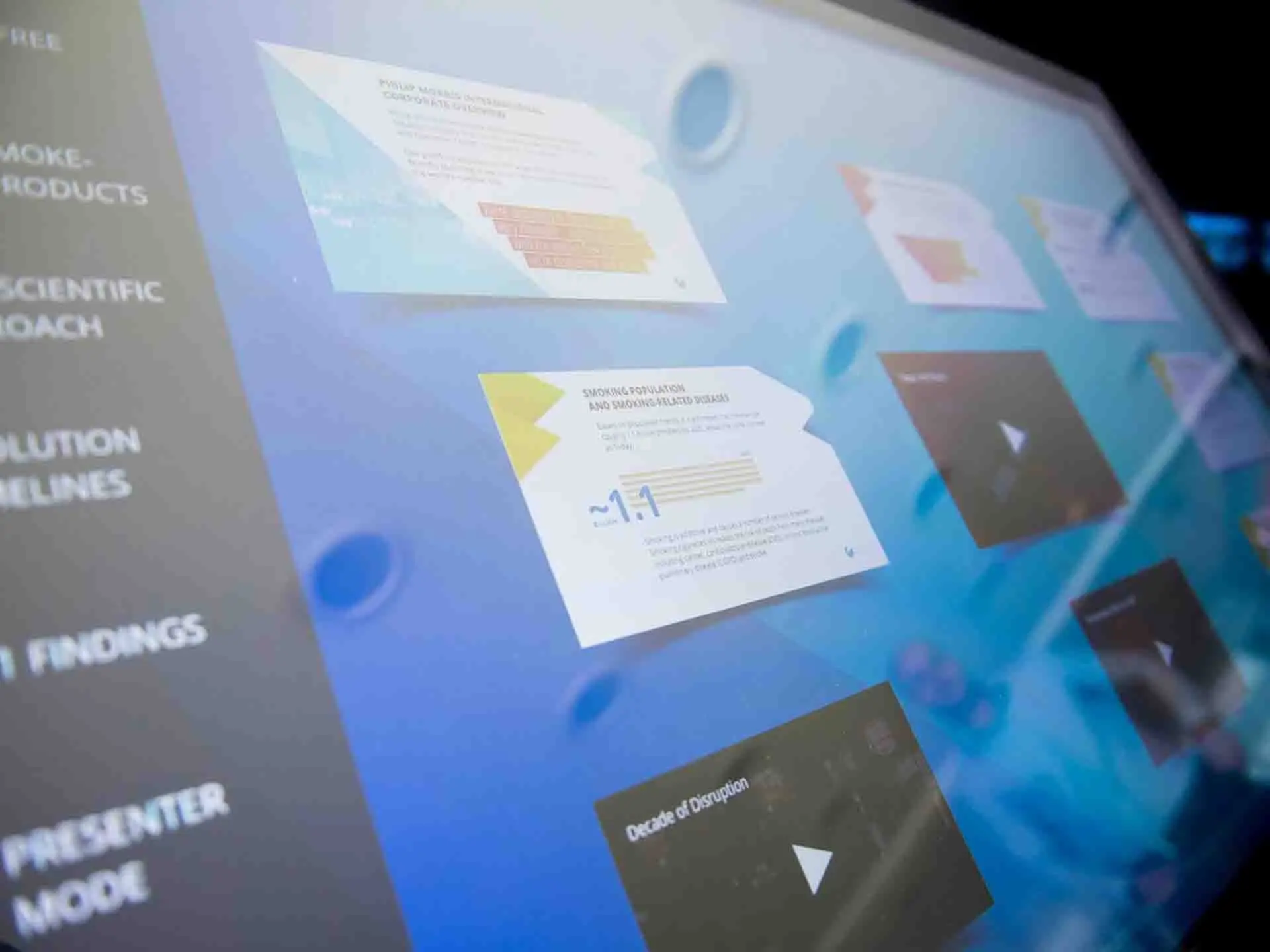Originally published September 9, 2025 , updated on September 10, 2025
Interactive content is changing the way healthcare brands connect with buyers. For a long time content like brochures and white papers carried most of the weight. They helped sales teams tell a story. They gave decision makers the data they needed to build a case.
That worked when choices were fewer and the noise was lower. Now, the noise is everywhere. Decision makers have endless vendors to compare and piles of information to sift through. A static PDF just doesn’t hold their attention anymore.
This is why interactive formats have changed the role of content in the buying cycle. They don’t just present information — they pull people in. A demo that lets a clinician explore a workflow or a webinar that sparks discussion are tools that make your value clear and your message stick.
That is why many marketers are rethinking how they deliver content. Interactive formats – tools that invite participation and offer tailored value – are becoming an essential part of content marketing in B2B healthcare.
How Content Supports the Healthcare Buying Journey

To create content that achieves your goal – signing a deal – you’ve got to understand what buyers are dealing with. From the outside, healthcare sales can feel slow. But behind the scenes, there’s usually a clear path. Every stage is a chance to support the conversation and help it keep moving. Here’s how content can make itself useful at each step:
Step 1: Identifying the Need
It usually kicks off when someone inside the organization realizes something’s off – maybe a system is falling behind or a new regulation needs attention. Early on, your content should help name the problem and show that there’s a better way forward. Think explainers or blogs that will show up when they are searching online for solutions. If you can speak to the issue in a way that feels relevant, you’re more likely to get noticed.
Step 2: Exploring Options
Once the problem’s clear, the team starts digging into solutions. They’re checking out vendors and researching to find out what’s worth considering. Your content shouldn’t try to sell everything at once. Instead, focus on helping them compare. Overview guides and comparison tools help show where you fit and why that matters.
Step 3: Evaluating the Details
At this point, the questions get more serious. Can this work for us? What’s it going to cost? Is it secure? Compliant? This is where you need deeper content. Case studies and regulatory documents can help shift the tone from interest to trust.
Step 4: Building Internal Buy-In
The person doing the research is often not the person who signs off on the deal. They need to take what they’ve learned and explain it to others – finance, IT, clinical leadership, procurement. If your content helps them make that case – through clear summaries or pitch-ready decks – you’ve made yourself useful.
Step 5: Deciding and Moving Forward
If you’ve made it this far, it’s about reassurance. Buyers want to feel like the risk is low and the rollout simple. This is where content like testimonials or onboarding guides comes in. Anything that shows “we’ve done this before, and we’ll guide you through it” matters now.
When your content supports each step of the process, it becomes part of the sale. Content marketing for B2B healthcare strategies works best when it’s built to move with the deal, not just sit on a landing page. And the more focused and practical your content is, the more likely it is to be passed around by the people who matter.
Because in most healthcare deals, one person doesn’t make the call. There’s a team behind every yes or no. They all bring different concerns, and your content has to hold up in those different rooms.
That’s the reality for healthcare marketers. And it’s why generic content often gets ignored. If you want to stay part of the conversation, your content needs to flex with the process. That’s where interactive content starts to really earn its place.
What Interactive Content Does and Why It Works in Healthcare
Interactive content isn’t new, but the way it works is what makes it valuable, especially in healthcare. At its core, interactive content asks the buyer to do something. That could mean clicking through a tool, answering a question, exploring a demo, or using a calculator. It’s simple, but the effect is powerful: it shifts the experience from passive to active. And that matters more than you might think.
People understand and remember more when they engage with something directly. That’s basic learning science. And in a space like content marketing for B2B healthcare, where buyers are busy and cautious, that kind of engagement is critical.
Here’s why it works:
- It holds attention. Interactive formats have been shown to drive more than 50% more engagement than static ones. That means more time with your message, which helps it land.
- It improves understanding. Tools that involve buyers like quizzes, calculators, or demos help them process information more deeply. 93% of marketers say it’s more effective at educating buyers.
- It increases recall. When people interact with content, they’re more likely to remember it – up to 79% more, according to some studies. That’s essential when decisions can take months.
- It reduces friction. Buyers can get the answers they care about at their own pace. That makes decision-making easier and faster.
- It drives results. Better engagement and better clarity mean better outcomes. Interactive content consistently outperforms static assets when it comes to conversions. That’s why it has become a cornerstone of content marketing for B2B in healthcare.
This is why interactive formats are such a good fit for a healthcare content strategy. When you’re selling into complex, slow-moving buying cycles, you need content that gives value fast. Static content might tick the box. But interactive content moves the deal forward.
The Value of Interactive Content in Sales
In healthcare, buyers want information, but they also want ways to test and compare and picture how a solution fits into their world. That’s where interactive content earns its place. Instead of asking people to skim another PDF or slide deck, it invites them to get involved.
Here’s how it proves its value in the sales process:
· Quizzes and assessments give buyers a quick way to spot gaps or challenges they may not have named yet. They’re also a good lead-generation tool – buyers get instant, personalized insights. Plus, you get a window into what matters to them.
· ROI calculators and budget tools speak the language of procurement and finance. When someone inevitably asks, “Is this worth it?”, you’ve already armed them with numbers they can trust. Running the math early keeps the deal from stalling later. They’re a classic example of how content marketing in B2B healthcare can directly support decision-making.
· Interactive infographics turn dense data like workflow stats, clinical results, or side-by-side product comparisons into something easier to digest and share. They’re especially useful for buyers doing early research or trying to brief their colleagues.
· Virtual demos and simulations let decision makers see how a tool or product works without needing to book a call. In long sales cycles, this hands-on experience builds confidence long before a formal demo.
· Webinars and interactive videos combine education with peer validation. Buyers can hear directly from industry experts and ask questions in real time without feeling like they’re being sold to.
The real advantage is twofold. Interactive formats build stronger connections with buyers, and they give you valuable insight into what those buyers actually care about. That combination is what turns interest into opportunity.

Case Study: How Butterfly Network Uses Interactive Content to Engage Healthcare Buyers
Butterfly Network, a leader in portable ultrasound, shows how interactive content can educate and engage decision makers in healthcare’s buying cycle. At Modern Healthcare’s “The Hospital of the Future” virtual briefing, Butterfly hosted an interactive session. The format gave prospects a chance to hear from both clinical and executive voices. This created a powerful mix of thought leadership and peer validation. By hosting this event live, Butterfly positioned itself as an educator and partner – not just a vendor.
The content also lived on after the event as an on-demand resource, extending reach to decision makers who couldn’t attend live. That combination of immediacy and flexibility made the content more convenient and relevant for busy healthcare leaders.
This is a strong example of how healthcare content marketing can use interactive formats to build trust and generate leads. For organizations trying to sell into hospitals or health systems, the lesson is clear: when your content helps buyers learn and apply insights directly to their work, it becomes part of their decision-making process.
Why You Need a B2B Healthcare Content Strategy
It’s easy to jump straight into creating content. You’ve got ideas and you want to get them out there. But without a strategy, even good content risks falling flat. A content strategy is what makes sure your efforts are working toward something bigger. It connects each piece to a clear goal in the buying process.
In healthcare content marketing for B2B, this is critical. We’ve already established the challenges that buyers are cautious and timelines are long, and that decisions often involve multiple voices. A strategy helps you plan content that speaks to those different needs, whether it’s a clinical leader looking for outcomes data or a finance manager wanting to see ROI. Instead of publishing content in isolation, you’re creating a flow that moves people from awareness through to decision. That structure gives your content more weight, and it gives your sales team something they can use.
A content strategy also makes distribution more targeted. The best interactive calculator or webinar means little if the right people never see it. With a healthcare content strategy, you’re planning how they’ll reach decision makers in the channels they already use, from LinkedIn to email to provider portals. The result is content that’s visible and far more effective at generating and converting leads.
Key Challenges (and Solutions) for Interactive Content in Healthcare
Buyers aren’t just looking for slick tools — they expect accuracy, compliance, security and convenience. Below are some of the most common challenges, along with simple ways to address them.
1. Producing Accurate, Evidence-Based Content
Healthcare content must be built on reliable data and scientific evidence. One wrong claim can damage trust.
Solution: Build review into your process. Involve clinicians or subject-matter experts in content creation, and always cite sources.
2. Meeting Compliance and Regulatory Standards
Privacy and regulations like HIPAA add layers of risk when creating interactive tools.
Solution: Choose formats that avoid sensitive data where possible. When collecting data, work with legal teams early to ensure compliance.
3. Making Content Easy to Use
Healthcare professionals are busy and often on mobile devices. A clunky calculator or confusing demo will lose them.
Solution: Keep tools simple. Prioritize mobile-friendly design and clear navigation.
4. Building Credibility and Trust
Decision makers need to know the content is accurate as well as credible and professional.
Solution: Use case studies and peer testimonials to reinforce authority.
5. Overcoming Technological and Cost Barriers
Custom interactive content can be expensive and time-consuming to build.
Solution: Start small. Use adaptable formats (like quizzes or calculators) before moving into more complex simulations.
6. Engaging Time-Pressed Professionals
Clinicians and administrators don’t have hours to spend on marketing content.
Solution: Create interactive formats that deliver value in minutes, such as quick self-assessments or short on-demand demos.

The companies that succeed in healthcare content marketing won’t be the ones producing the most content. They’ll be the ones producing interactive content that buyers remember and rely on when it’s time to choose.
Turning Interactive Content into a Competitive Advantage
In summary, content marketing for B2B healthcare is the discipline of using targeted, credible content to influence high-stakes purchasing decisions. It’s not about chasing clicks or quick wins. Instead, it’s about building trust and educating multiple stakeholders and is designed to guide buyers through long, complex sales cycles.
If you’re ready to build interactive content that drives results, partnering with a healthcare content marketing agency like Goodman Lantern can give you the expertise and strategy to get there. Get in touch to find out more about our B2B content marketing for healthcare services.
Post Views: 194


















